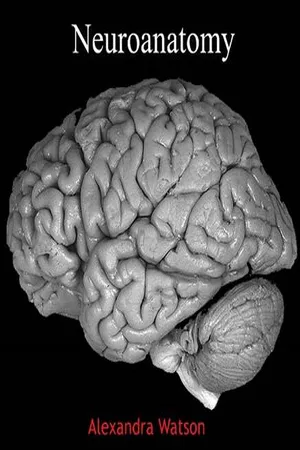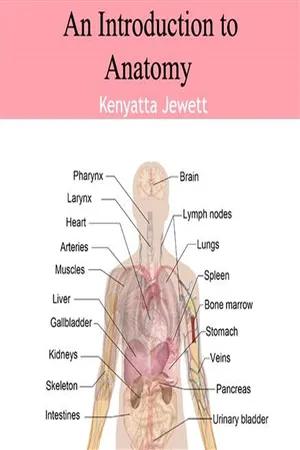Biological Sciences
Nervous Coordination
Nervous coordination refers to the process by which the nervous system transmits and integrates information to regulate and coordinate the activities of different parts of the body. This involves the transmission of electrical impulses along nerve cells and the release of chemical messengers called neurotransmitters. Nervous coordination plays a crucial role in controlling movement, sensation, and other physiological functions.
Written by Perlego with AI-assistance
Related key terms
1 of 5
7 Key excerpts on "Nervous Coordination"
- No longer available |Learn more
- Azhar ul Haque Sario(Author)
- 2023(Publication Date)
- tredition(Publisher)
Coordination and controlMammalian nervous systemThe nervous system, encompassing the brain, spinal cord, and a myriad of nerves, functions as the supreme command center of our bodies. Picture it as an ultramodern control room, deftly managing a wide array of tasks with remarkable coordination.At the center of this intricate system lies the brain, nature's masterpiece, acting as the top boss of our body. It decodes messages from our senses, processes our thoughts, and guides our emotions, much like an advanced computer that constantly sifts through and reacts to incoming information.The spinal cord serves as a crucial link, akin to a highspeed expressway, ferrying messages to and fro between the brain and the rest of the body. Imagine it as the primary communication line, carrying essential messages rapidly and effectively, ensuring our actions and responses are prompt and precise.Then, there are the nerves, spreading out like an extensive network. These are the diligent couriers of the system, transmitting essential signals throughout the body. They ensure everything, from a simple blink to the steady rhythm of the heart, is impeccably synchronized. They resemble tireless messengers, relaying information constantly to maintain the body's smooth operation.Working together, these parts form a symphony of seamless coordination, like a perfectly conducted orchestra. They regulate and harmonize all bodily functions, from the simplest reflex to the most complex cerebral activities. The nervous system is the conductor, making sure our bodies function like a well-oiled machine, always responsive and adaptable to our surroundings.The mammalian nervous system is an intricate and advanced network, much like the central command in a vast, complex organization. It is essential for controlling all bodily functions and managing how mammals interact with their surroundings. This remarkable system is mainly divided into two key parts: the Central Nervous System (CNS) and the Peripheral Nervous System (PNS). - No longer available |Learn more
- (Author)
- 2014(Publication Date)
- Research World(Publisher)
Thus, neural signaling is capable of a much higher level of specificity than hormonal signaling. It is also much faster: the fastest nerve signals travel at speeds that exceed 100 meters per second. At a more integrative level, the primary function of the nervous system is to control the body. It does this by extracting information from the environment using sensory receptors, sending signals that encode this information into the central nervous system, processing the information to determine an appropriate response, and sending output signals to muscles or glands to activate the response. The evolution of a complex nervous system has made it possible for various animal species to have advanced perception abilities such as vision, complex social interactions, rapid coordination of organ systems, and integrated processing of concurrent signals. In humans, the sophistication of the nervous system makes it possible to have language, abstract representation of concepts, transmission of culture, and many other features of human society that would not exist without the human brain. Neurons and synapses Major elements in synaptic transmission. An electrochemical wave called an action potential travels along the axon of a neuron. When the wave reaches a synapse, it provokes release of a puff of neurotransmitter molecules, which bind to chemical receptor molecules located in the membrane of the target cell. ________________________ WORLD TECHNOLOGIES ________________________ Most neurons send signals via their axons, although some types are capable of dendrite-to-dendrite communication. (In fact, the types of neurons called amacrine cells have no axons, and communicate only via their dendrites.) Neural signals propagate along an axon in the form of electrochemical waves called action potentials, which produce cell-to-cell signals at points where axon terminals make synaptic contact with other cells. - No longer available |Learn more
- (Author)
- 2014(Publication Date)
- Research World(Publisher)
The concept of a command neuron has, however, become controversial, because of studies showing that some neurons that initia lly appeared to fit the description were really only capable of evoking a response in a limited set of circumstances. Function At the most basic level, the function of the nervous system is to send signals from one cell to others, or from one part of the body to others. There are multiple ways that a cell can send signals to other cells. One is by releasing chemicals called hormones into the internal circulation, so that they can diffuse to distant sites. In contrast to this broadcast ________________________ WORLD TECHNOLOGIES ________________________ mode of signaling, the nervous system provides point -to-point signals —neurons project their axons to specific target areas and make synaptic connections with specific target cells. Thus, neural signaling is capable of a much higher level of specificity than hormonal signali ng. It is also much faster: the fastest nerve signals travel at speeds that exceed 100 meters per second. At a more integrative level, the primary function of the nervous system is to control the body. It does this by extracting information from the enviro nment using sensory receptors, sending signals that encode this information into the central nervous system, processing the information to determine an appropriate response, and sending output signals to muscles or glands to activate the response. The evol ution of a complex nervous system has made it possible for various animal species to have advanced perception abilities such as vision, complex social interactions, rapid coordination of organ systems, and integrated processing of concurrent signals. In hu mans, the sophistication of the nervous system makes it possible to have language, abstract representation of concepts, transmission of culture, and many other features of human society that would not exist without the human brain. - No longer available |Learn more
- (Author)
- 2014(Publication Date)
- College Publishing House(Publisher)
The concept of a command neuron has, however, become controversial, because of studies showing that some neurons that initially appeared to fit ________________________ WORLD TECHNOLOGIES ________________________ the description were really only capable of evoking a response in a limited set of cir-cumstances. Function At the most basic level, the function of the nervous system is to send signals from one cell to others, or from one part of the body to others. There are multiple ways that a cell can send signals to other cells. One is by releasing chemicals called hormones into the internal circulation, so that they can diffuse to distant sites. In contrast to this broadcast mode of signaling, the nervous system provides point-to-point signals—neurons project their axons to specific target areas and make synaptic connections with specific target cells. Thus, neural signaling is capable of a much higher level of specificity than hormonal signaling. It is also much faster: the fastest nerve signals travel at speeds that exceed 100 meters per second. At a more integrative level, the primary function of the nervous system is to control the body. It does this by extracting information from the environment using sensory re-ceptors, sending signals that encode this information into the central nervous system, processing the information to determine an appropriate response, and sending output signals to muscles or glands to activate the response. The evolution of a complex nervous system has made it possible for various animal species to have advanced perception abilities such as vision, complex social interactions, rapid coordination of organ systems, and integrated processing of concurrent signals. In humans, the sophistication of the nervous system makes it possible to have language, abstract representation of concepts, transmission of culture, and many other features of human society that would not exist without the human brain. - No longer available |Learn more
- (Author)
- 2014(Publication Date)
- Research World(Publisher)
The concept of a command neuron has, however, become controversial, because of studies showing that some neurons that initially appeared to fit ________________________ WORLD TECHNOLOGIES ________________________ the description were really only capable of evoking a response in a limited set of circumstances. Function At the most basic level, the function of the nervous system is to send signals from one cell to others, or from one part of the body to others. There are multiple ways that a cell can send signals to other cells. One is by releasing chemicals called hormones into the internal circulation, so that they can diffuse to distant sites. In contrast to this broadcast mode of signaling, the nervous system provides point-to-point signals—neurons project their axons to specific target areas and make synaptic connections with specific target cells. Thus, neural signaling is capable of a much higher level of specificity than hormonal signaling. It is also much faster: the fastest nerve signals travel at speeds that exceed 100 meters per second. At a more integrative level, the primary function of the nervous system is to control the body. It does this by extracting information from the environment using sensory receptors, sending signals that encode this information into the central nervous system, processing the information to determine an appropriate response, and sending output signals to muscles or glands to activate the response. The evolution of a complex nervous system has made it possible for various animal species to have advanced perception abilities such as vision, complex social interactions, rapid coordination of organ systems, and integrated processing of concurrent signals. In humans, the sophistication of the nervous system makes it possible to have language, abstract representation of concepts, transmission of culture, and many other features of human society that would not exist without the human brain. - eBook - PDF
- Douglas Bernstein, , , (Authors)
- 2015(Publication Date)
- Cengage Learning EMEA(Publisher)
Studying the biology of behavior and mental processes also involves exploring the environment’s role in influencing those processes. You will see later, for example, that the experiences we have in the environment can change the chemistry and even the structure of our brains. In this chapter we begin to consider in more detail the relationship between your body and your mind, between your brain and your behavior. We will begin by considering the nervous system , the billions of cells that make up your brain, spinal cord, and nerves. The nervous system receives information, analyzes it, and sends messages from one part of the body to another. The combined activity of these cells helps you gather information, make decisions, and take action. Another system, the endocrine (pronounced “END-oh-krin”) system, also helps direct body activities. It reg-ulates internal activity of the body with glands that secrete chemicals, called hormones, into the bloodstream. Hormones affect energy consumption, reactions to stress, sexual functioning, and more. The nervous system and the endocrine system affect each other to coordinate activities of the body. Putting the pieces together about how all this happens is the next step in our understanding of the biology of our complex behavior. CELLS OF THE NERVOUS SYSTEM What are neurons, and what do they do? The nervous system is a vast network of cells that tells you what is going on inside and outside your body and allows you to respond appropriately. For example, if you are jabbed with a pin, your nervous system gets the message and immediately causes you to flinch. But the nervous system can do far more than detect information and make responses. When information about the world reaches the brain, that information is processed —it is combined with information about past experiences and current wants and needs—to allow you to decide how to respond. - eBook - PDF
The Insects
Structure and Function
- R. F. Chapman, Stephen J. Simpson, Angela E. Douglas(Authors)
- 2012(Publication Date)
- Cambridge University Press(Publisher)
Part V Communication 20 Nervous system REVISED AND UPDATED BY STEPHEN ROGERS INTRODUCTION The central nervous system is ultimately responsible for producing behavior. It synthesizes inputs from arrays of sensory neurons that individually can only encode or represent tiny parts of the total environment and produces sophisticated representations of the outside world and the internal state of the insect. It is responsible for integrating these many different sensory inputs and deciding upon and organizing appropriate behavioral responses. It does this by coordinating the activity of the approximately 300 skeletal muscles that articulate the body in a precise temporal and spatial manner, all while monitoring the consequences of its own activity during ongoing behavior. The sensory systems are considered in Chapters 22–24, and the stomodeal system, regulating gut activity, is described in Section 3.1.7. In this chapter the basic cellular components of the nervous system, both nerve cells and the supporting glial cells, are described in Section 20.1. The means by which neurons carry signals and communicate with each other is covered in Section 20.2. In Section 20.3 the anatomy of the ventral nerve cord along with the structure and function of some of the different kinds of neurons found within are considered. Section 20.4 deals with the large-scale anatomy of the brain, together with some discussion of how different regions are specialized for different functions. Finally, in Section 20.5 a few examples of how networks of neurons work together to integrate and analyze sensory information, coordinate complex movements and learn new information are described. The Insects: Structure and Function (5 th edition), ed. S. J. Simpson and A. E. Douglas. Published by Cambridge University Press. © Cambridge University Press 2013. 20.1 Basic components 20.1.1 Neuron The basic element in the nervous system is the nerve cell, or neuron (Fig. 20.1).
Index pages curate the most relevant extracts from our library of academic textbooks. They’ve been created using an in-house natural language model (NLM), each adding context and meaning to key research topics.






